Given the code fragment:
ZonedDateTime depart = ZonedDateTime.of(2015, 1, 15, 3, 0, 0, 0, ZoneID.of(“UTC-7”));
ZonedDateTime arrive = ZonedDateTime.of(2015, 1, 15, 9, 0, 0, 0, ZoneID.of(“UTC-5”));
long hrs = ChronoUnit.HOURS.between(depart, arrive); //line n1
System.out.println(“Travel time is” + hrs + “hours”);
What is the result?
Given the EMPLOYEE table;

Given the code fragment:

Assuming the database supports scrolling and updating, what is the result?
Given the code fragment:
List
List
//line n1
Which code fragment, when inserted at line n1, prints 10 20 15 30?
Given the content of resources /Message.properties:
greet = Good Day!
Given the content of resources/Message_de_DE.properties:
greet = Guten Tag!
Given the code fragment from C:\src\App.java:

Given:
public class Product {
int id; int price;
public Product (int id, int price) {
this.id = id;
this.price = price;
}
Public String toString () { return id + “:” + price;)
}
and the code fragment:
List
new Product (2, 30),
new Product (3, 20));
Product p = products.stream().reduce(new Product (4, 0), (p1, p2) -> {
p1.price+=p2.price;
return new Product (p1.id, p1.price);});
products.add(p);
products.stream().parallel()
.reduce((p1, p2) - > p1.price > p2.price ? p1 : p2)
.ifPresent(System.out: :println);
What is the result?
Given the records from the Employee table:

and given the code fragment:
try {
Connection conn = DriverManager.getConnection (URL, userName, passWord);
Statement st = conn.createStatement(ResultSet.TYPE_SCROLL_INSENSITIVE,
ResultSet.CONCUR_UPDATABLE);
st.execute(“SELECT*FROM Employee”);
ResultSet rs = st.getResultSet();
while (rs.next()) {
if (rs.getInt(1) ==112) {
rs.updateString(2, “Jack”);
}
}
rs.absolute(2);
System.out.println(rs.getInt(1) + “ “ + rs.getString(2));
} catch (SQLException ex) {
System.out.println(“Exception is raised”);
}
Assume that:
The required database driver is configured in the classpath.
The appropriate database accessible with the URL, userName, and passWord exists.
What is the result?
Given the code fragment:
LocalDate valentinesDay =LocalDate.of(2015, Month.FEBRUARY, 14);
LocalDate next15days = valentinesDay.plusDays (15);
LocalDate nextYear = next15days.plusYears(1); // line n1
System.out.println(nextYear);
What is the result?
Given:
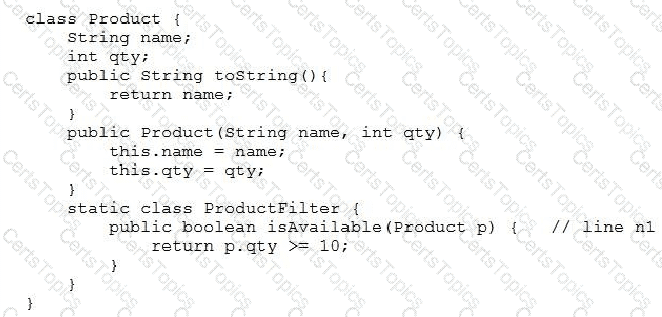
and the code fragment:

Which modification enables the code fragment to print Speaker?
Given:
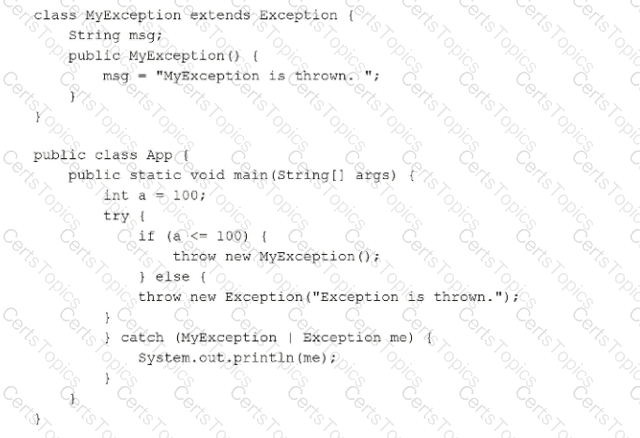
What is the result?
Which statement is true about the single abstract method of the java.util.function.Function interface?
Given:
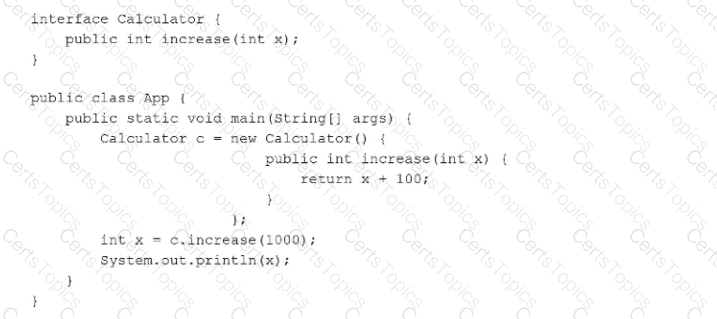
Which is refactored code with functional interfaces?
Given:
final class Folder {//line n1
//line n2
public void open () {
System.out.print(“Open”);
}
}
public class Test {
public static void main (String [] args) throws Exception {
try (Folder f = new Folder()) {
f.open();
}
}
}
Which two modifications enable the code to print Open Close? (Choose two.)
Given the structure of the EHF and DEPT tables:

Given the code fragment:

What is the result?
Given the code fragment:

Assume that the value of now is 6:30 in the morning.
What is the result?
Given:
class Book {
int id;
String name;
public Book (int id, String name) {
this.id = id;
this.name = name;
}
public boolean equals (Object obj) { //line n1
boolean output = false;
Book b = (Book) obj;
if (this.name.equals(b name))}
output = true;
}
return output;
}
}
and the code fragment:
Book b1 = new Book (101, “Java Programing”);
Book b2 = new Book (102, “Java Programing”);
System.out.println (b1.equals(b2)); //line n2
Which statement is true?
Given the code fragment:
List
Function
nL.Stream()
.map(funVal)
.forEach(s-> System.out.print (s));
What is the result?
Given:
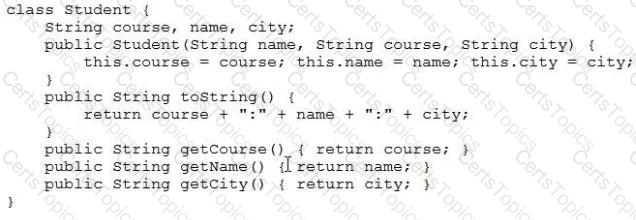
and the code fragment:

What is the result?
You have been asked to create a ResourceBundle which uses a properties file to localize an application.
Which code example specifies valid keys of menu1 and menu2 with values of File Menu and View Menu?
Given the code fragment:

What is the result?
Given the code fragment:
Path path1 = Paths.get(“/app/./sys/”);
Path res1 = path1.resolve(“log”);
Path path2 = Paths.get(“/server/exe/”);
Path res1 = path2.resolve(“/readme/”);
System.out.println(res1);
System.out.println(res2);
What is the result?

and the code fragment?

What is the result?
Given the code fragment:

What is the result?
Given:

and the code fragment:

What is the result?
Given the code fragment:

What is the result?
Given the code fragment:
9. Connection conn = DriveManager.getConnection(dbURL, userName, passWord);
10. String query = “SELECT id FROM Employee”;
11. try (Statement stmt = conn.createStatement()) {
12. ResultSet rs = stmt.executeQuery(query);
13.stmt.executeQuery(“SELECT id FROM Customer”);
14. while (rs.next()) {
15. //process the results
16.System.out.println(“Employee ID: “+ rs.getInt(“id”));
17.}
18. } catch (Exception e) {
19. System.out.println (“Error”);
20. }
Assume that:
The required database driver is configured in the classpath.
The appropriate database is accessible with the dbURL, userName, and passWord exists.
The Employee and Customer tables are available and each table has id column with a few records and the SQL queries are valid.
What is the result of compiling and executing this code fragment?
Given the code fragment:

Which two code fragments, when inserted at line n1 independently, result in the output PEEK: Unix?
Given the content:
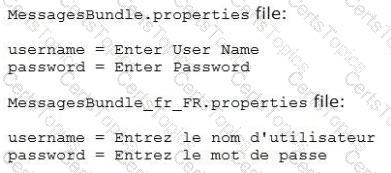
and the code fragment:

What is the result?
Given that course.txt is accessible and contains:
Course : : Java
and given the code fragment:
public static void main (String[ ] args) {
int i;
char c;
try (FileInputStream fis = new FileInputStream (“course.txt”);
InputStreamReader isr = new InputStreamReader(fis);) {
while (isr.ready()) { //line n1
isr.skip(2);
i = isr.read ();
c = (char) i;
System.out.print(c);
}
} catch (Exception e) {
e.printStackTrace();
}
}
What is the result?
Given that data.txt and alldata.txt are accessible, and the code fragment:

What is required at line n1 to enable the code to overwrite alldata.txt with data.txt?
Given:

and the code fragment:

What is the result?
You want to create a singleton class by using the Singleton design pattern.
Which two statements enforce the singleton nature of the design? (Choose two.)
Given the structure of the Student table:
Student (id INTEGER, name VARCHAR)
Given the records from the STUDENT table:

Given the code fragment:

Assume that:
What is the result?
Given:
class FuelNotAvailException extends Exception { }
class Vehicle {
void ride() throws FuelNotAvailException {//line n1
System.out.println(“Happy Journey!”);
}
}
class SolarVehicle extends Vehicle {
public void ride () throws FuelNotAvailException {//line n2
super ride ();
}
}
and the code fragment:
public static void main (String[] args) throws Exception {
Vehicle v = new SolarVehicle ();
v.ride();
}
Which modification enables the code fragment to print Happy Journey!?
Given:
public interface Moveable
public default void walk (Integer distance) {System.out.println(“Walking”);)
public void run(Integer distance);
}
Which statement is true?
Given:
class UserException extends Exception { }
class AgeOutOfLimitException extends UserException { }
and the code fragment:
class App {
public void doRegister(String name, int age)
throws UserException, AgeOutOfLimitException {
if (name.length () <= 60) {
throw new UserException ();
} else if (age > 60) {
throw new AgeOutOfLimitException ();
} else {
System.out.println(“User is registered.”);
}
}
public static void main(String[ ] args) throws UserException {
App t = new App ();
t.doRegister(“Mathew”, 60);
}
}
What is the result?
Given:
class CheckClass {
public static int checkValue (String s1, String s2) {
return s1 length() – s2.length();
}
}
and the code fragment:
String[] strArray = new String [] {“Tiger”, “Rat”, “Cat”, “Lion”}
//line n1
for (String s : strArray) {
System.out.print (s + “ “);
}
Which code fragment should be inserted at line n1 to enable the code to print Rat Cat Lion Tiger?
Given the information: The employee table has 10 records.
Given the code fragment:

What is the result?
Which statement is true about the single abstract method of the java.util.function.Predicate interface?
The data.doc, data.txt and data.xml files are accessible and contain text.
Given the code fragment:
Stream
Paths. get(“data.txt”),
Paths. get(“data.xml”));
paths.filter(s-> s.toString().endWith(“txt”)).forEach(
s -> {
try {
Files.readAllLines(s)
.stream()
.forEach(System.out::println); //line n1
} catch (IOException e) {
System.out.println(“Exception”);
}
}
);
What is the result?
Given the code fragment:
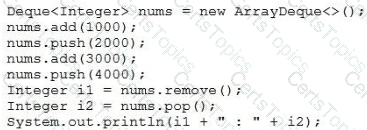
What is the result?
Given:
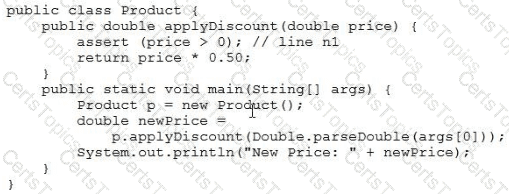
and the command:
java Product 0
What is the result?
Given the code fragments:

and

What is the result?
Given the code fragment:

Which statement can be inserted into line n1 to print 1,2; 1,10; 2,20;?
Given that version.txt is accessible and contains:
1234567890
and given the code fragment:
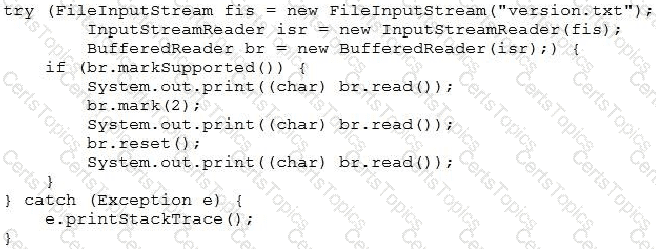
What is the result?
Given the code fragment:

Which should be inserted into line n1 to print Average = 2.5?
Given the structure of the STUDENT table:
Student (id INTEGER, name VARCHAR)
Given:
public class Test {
static Connection newConnection =null;
public static Connection get DBConnection () throws SQLException {
try (Connection con = DriveManager.getConnection(URL, username, password)) {
newConnection = con;
}
return newConnection;
}
public static void main (String [] args) throws SQLException {
get DBConnection ();
Statement st = newConnection.createStatement();
st.executeUpdate(“INSERT INTO student VALUES (102, ‘Kelvin’)”);
}
}
Assume that:
The required database driver is configured in the classpath.
The appropriate database is accessible with the URL, userName, and passWord exists.
The SQL query is valid.
What is the result?
Given the code fragments:

and

What is the result?
Given:
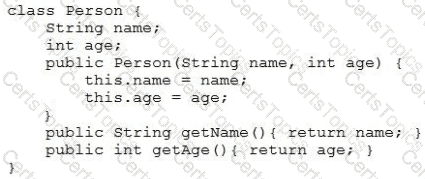
and the code fragment:

What is the result?
Given the code fragment:
List
System.out.println (
// line n1
);
Which code fragment, when inserted at line n1, enables the code to print the count of string elements whose length is greater than three?
Given the code fragments :

and

What is the result?
Given the code fragment:
Stream
Arrays.asList (“1”, “John”),
Arrays.asList (“2”, null)0;
Stream<
nInSt.forEach (System.out :: print);
What is the result?
Given the code fragment:
Stream
files.forEach (fName -> {//line n1
try {
Path aPath = fName.toAbsolutePath();//line n2
System.out.println(fName + “:”
+ Files.readAttributes(aPath, Basic.File.Attributes.class).creationTime
());
} catch (IOException ex) {
ex.printStackTrace();
});
What is the result?
Given:
public class Customer {
private String fName;
private String lName;
private static int count;
public customer (String first, String last) {fName = first, lName = last;
++count;}
static { count = 0; }
public static int getCount() {return count; }
}
public class App {
public static void main (String [] args) {
Customer c1 = new Customer(“Larry”, “Smith”);
Customer c2 = new Customer(“Pedro”, “Gonzales”);
Customer c3 = new Customer(“Penny”, “Jones”);
Customer c4 = new Customer(“Lars”, “Svenson”);
c4 = null;
c3 = c2;
System.out.println (Customer.getCount());
}
}
What is the result?
Given:
public class Counter {
public static void main (String[ ] args) {
int a = 10;
int b = -1;
assert (b >=1) : “Invalid Denominator”;
int с = a / b;
System.out.println (c);
}
}
What is the result of running the code with the –da option?
Given the code fragment:
List
System.out.println (
//line n1
);
Which code fragment must be inserted at line n1 to enable the code to print the maximum number in the nums list?
Given:
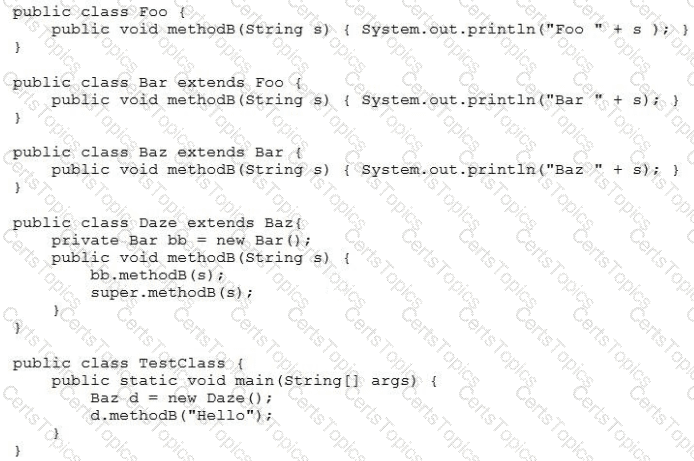
What is the result?
Given the code fragment:
List
values.stream ()
.map(n -> n*2)//line n1
.peek(System.out::print)//line n2
.count();
What is the result?
Given the code fragment:
UnaryOperator
List
loanValues.stream()
.filter(lv -> lv >= 1500)
.map(lv -> uo1.apply(lv))//line n2
.forEach(s -> System.out.print(s + “ “));
What is the result?
Given:

Which option fails?
Given the code fragments:
class Employee {
Optional
address;Employee (Optional
address) {this.address = address;
}
public Optional
getAddress() { return address; }}
class Address {
String city = “New York”;
public String getCity { return city: }
public String toString() {
return city;
}
}
and
Address address = null;
Optional
addrs1 = Optional.ofNullable (address);Employee e1 = new Employee (addrs1);
String eAddress = (addrs1.isPresent()) ? addrs1.get().getCity() : “City Not
available”;
What is the result?
Given:
Message.properties:
msg = Welcome!
Message_fr_FR.properties:
msg = Bienvenue!
Given the code fragment:
// line n1
Locale.setDefault(locale);
ResourceBundle bundle = ResourceBundle.getBundle("Message");
System.out.print(bundle.getString("msg"));
Which two code fragments, when inserted at line n1 independently, enable to print Bienvenue!?
Which code fragment is required to load a JDBC 3.0 driver?